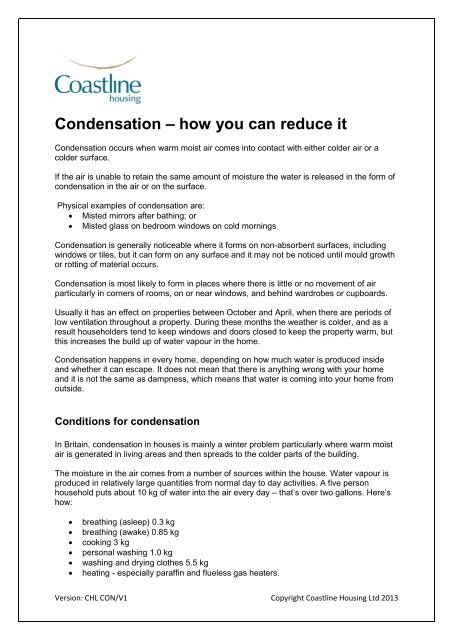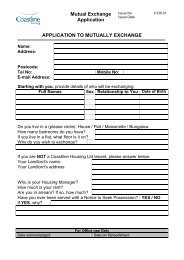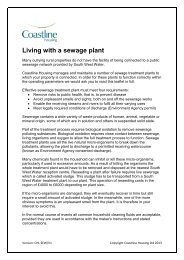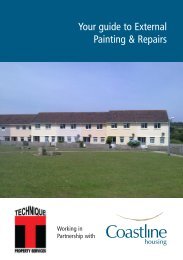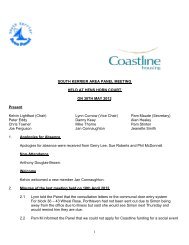Condensation leaflet - Coastline Housing
Condensation leaflet - Coastline Housing
Condensation leaflet - Coastline Housing
Create successful ePaper yourself
Turn your PDF publications into a flip-book with our unique Google optimized e-Paper software.
<strong>Condensation</strong> – how you can reduce it<br />
<strong>Condensation</strong> occurs when warm moist air comes into contact with either colder air or a<br />
colder surface.<br />
If the air is unable to retain the same amount of moisture the water is released in the form of<br />
condensation in the air or on the surface.<br />
Physical examples of condensation are:<br />
• Misted mirrors after bathing; or<br />
• Misted glass on bedroom windows on cold mornings<br />
<strong>Condensation</strong> is generally noticeable where it forms on non-absorbent surfaces, including<br />
windows or tiles, but it can form on any surface and it may not be noticed until mould growth<br />
or rotting of material occurs.<br />
<strong>Condensation</strong> is most likely to form in places where there is little or no movement of air<br />
particularly in corners of rooms, on or near windows, and behind wardrobes or cupboards.<br />
Usually it has an effect on properties between October and April, when there are periods of<br />
low ventilation throughout a property. During these months the weather is colder, and as a<br />
result householders tend to keep windows and doors closed to keep the property warm, but<br />
this increases the build up of water vapour in the home.<br />
<strong>Condensation</strong> happens in every home, depending on how much water is produced inside<br />
and whether it can escape. It does not mean that there is anything wrong with your home<br />
and it is not the same as dampness, which means that water is coming into your home from<br />
outside.<br />
Conditions for condensation<br />
In Britain, condensation in houses is mainly a winter problem particularly where warm moist<br />
air is generated in living areas and then spreads to the colder parts of the building.<br />
The moisture in the air comes from a number of sources within the house. Water vapour is<br />
produced in relatively large quantities from normal day to day activities. A five person<br />
household puts about 10 kg of water into the air every day – that’s over two gallons. Here’s<br />
how:<br />
• breathing (asleep) 0.3 kg<br />
• breathing (awake) 0.85 kg<br />
• cooking 3 kg<br />
• personal washing 1.0 kg<br />
• washing and drying clothes 5.5 kg<br />
• heating - especially paraffin and flueless gas heaters.<br />
Version: CHL CON/V1 Copyright <strong>Coastline</strong> <strong>Housing</strong> Ltd 2013
For every litre of paraffin burnt over one litre of moisture vaporises into air. Every carbon fuel<br />
produces some amount of water from combustion. (1 kg of water equates to about 1 litre)<br />
Modern life styles mean that many houses remain unoccupied and unheated throughout the<br />
greater part of the day, allowing the fabric of the building to cool down. The moisture<br />
producing activities are then concentrated into relatively short periods (morning and evening)<br />
when the structure is relatively cold while the building is still warming up.<br />
What you can do to prevent condensation<br />
You need to take sensible precautions to prevent and manage condensation because if left it<br />
can damage clothes, bedding and decorations. It can also cause staining and mould growth,<br />
especially in areas where there is little movement of air, such as behind furniture and in<br />
corners. It can also damage the building itself, causing timber to rot, especially if moist air is<br />
not allowed to escape.<br />
Following these 3 steps below can help reduce the amount of condensation in your home:<br />
Step 1 – Produce less moisture<br />
Do<br />
Don’t<br />
• Cover pans when cooking.<br />
• Hang wet washing outside as soon as you can.<br />
• Dry clothes outside wherever possible or if you insist on drying clothes indoors, do so<br />
in a closed bathroom with a window open and the extractor fan switched on.<br />
• Make sure that if you use a tumble drier, it is properly vented outside.<br />
• Close the bathroom door when washing or bathing and close the kitchen door when<br />
cooking. Let the moist air escape through the window and not into the house<br />
• Ensure that any extractor fans fitted are always used and the grilles are cleaned<br />
regularly<br />
• Leave kettles boiling.<br />
• Dry clothes indoors.<br />
• Use paraffin or potable flue-less bottled gas heaters; these heaters put a lot of<br />
moisture into the air – one gallon of gas or paraffin produces a gallon of water, so<br />
use a different form of heating.<br />
Step 2 – Make sure the moist air can escape<br />
Do<br />
• Always keep the trickle vents open on your windows where possible.<br />
• Use extractor fans in your bathroom and kitchen when bathing or cooking.<br />
• Open the windows - air the house for at least 20 minutes a day, ideally first thing in<br />
the mornings.<br />
Version: CHL CON/V1 Copyright <strong>Coastline</strong> <strong>Housing</strong> Ltd 2013
Don’t<br />
• Ventilate cupboards and wardrobes – open the doors regularly and avoid putting too<br />
many things in them as this stops air circulating.<br />
• Cover or block airbricks or vents – they are there for a reason.<br />
• Switch off extractor fans – let them work as they are supposed to.<br />
• Let steam stay in the bathroom after you have had a bath/shower – open the window.<br />
• Put furniture right up against a cold outside wall – move it away from the wall slightly<br />
– recommended 2 inches – so that air can circulate behind it, and if possible avoid<br />
positioning furniture alongside external walls.<br />
Step 3 – Heat your home<br />
Do<br />
Don’t<br />
• Keep low background heating on all the time in cold weather, even when there is no<br />
one at home, this avoids condensation occurring when the heating goes off and as<br />
the air and surfaces cool.<br />
• Report any broken heaters, radiators and extractor fans so that we can repair them.<br />
• Leave any rooms unheated even if you don’t use them – you only need a very low<br />
background heat to prevent condensation.<br />
• Block any heaters or radiators with furniture or other belongings – you need to<br />
ensure that air can flow around them so that they can work efficiently.<br />
• Disturb the loft insulation in your home or store things in the loft that compress the<br />
insulation.<br />
Dealing with mould and moisture<br />
• <strong>Condensation</strong> on windows<br />
If you see condensation on your windows, simply wipe it away. It is important to do<br />
this regularly to stop any mould appearing on your window frames and on your<br />
window reveals. Make sure you dispose of the wet cloth or tissues outside of the<br />
room.<br />
• Mould<br />
If you see any mould, clean if off – use a proprietary mould and mildew cleaning<br />
solution readily available from many shops or a weak solution of ordinary bleach. To<br />
do this use one part bleach to 20 parts of water. It’s important not to leave mould –<br />
if you don’t wipe it away regularly, it can grow into soft materials such as plaster,<br />
which will mean that it will cause difficulty in decorating over it in the future.<br />
Remember<br />
Mild condensation is nothing to worry about and can be dealt with and managed by following<br />
the advice above. If you are adhering to the guidance offered but still concerned about<br />
Version: CHL CON/V1 Copyright <strong>Coastline</strong> <strong>Housing</strong> Ltd 2013
excessive mould in your home, please contact us and we will arrange for a survey to be<br />
undertaken at your home<br />
• Does your home or any specific rooms feel unusually cold<br />
• Do you have concerns with damp in your property<br />
• Do you find it difficult to heat your home<br />
If you answered yes to any of the above questions, please contact us and we will<br />
arrange for a visit to your home.<br />
Contact us on 08082 027728 or 01209 20020, or email<br />
customer.services@coastlinehousing.co.uk<br />
Version: CHL CON/V1 Copyright <strong>Coastline</strong> <strong>Housing</strong> Ltd 2013


